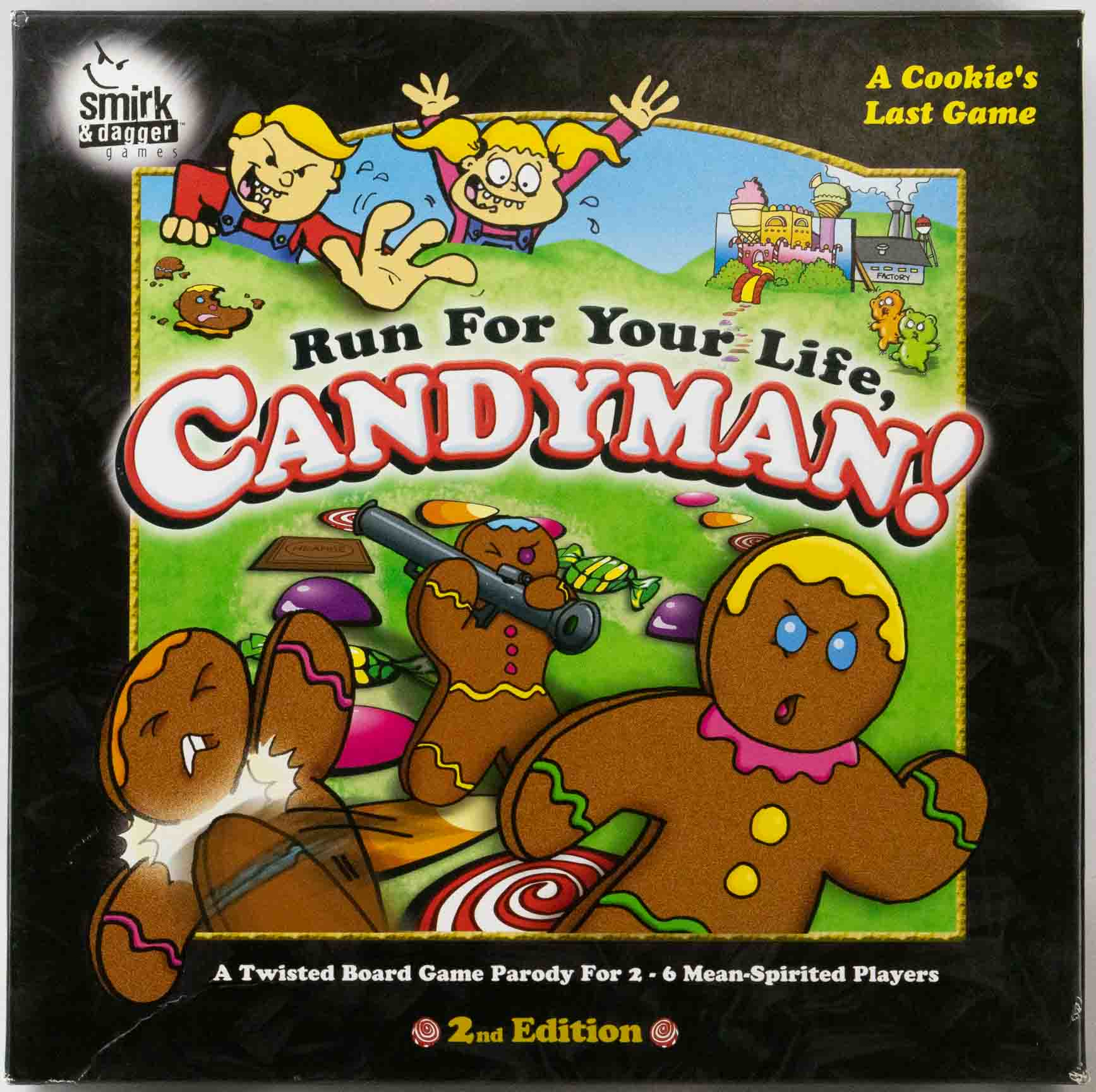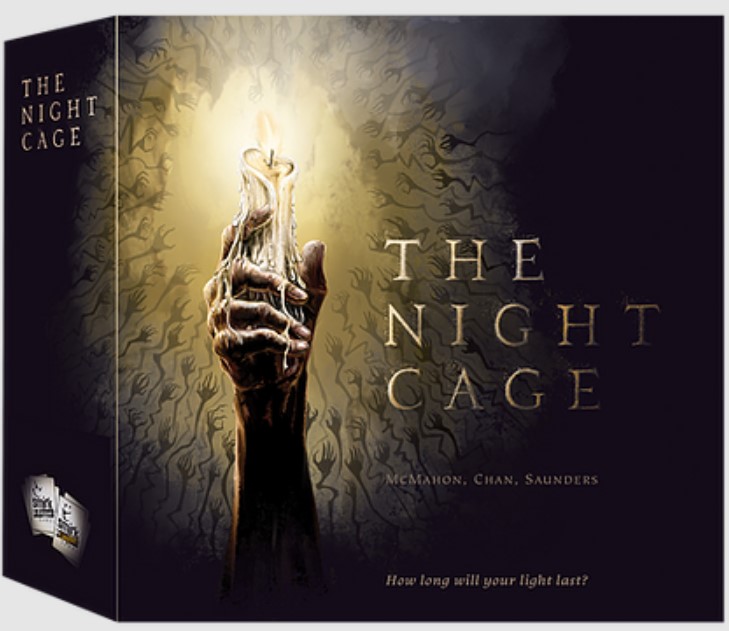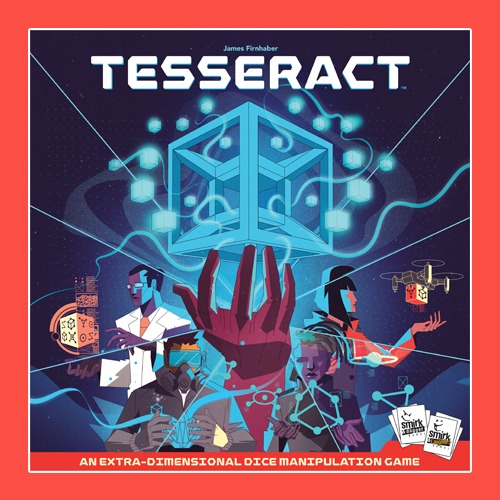Smirk & Dagger Games built its reputation on mischief. Founded by Curt Covert in 2003, the company specialized in take-that mechanics, with games that celebrate the joy of backstabbing your friends, all in the name of fun. Today, it’s known not only for chaotic classics like Dead Last and Run for your Life, Candyman! but also for more warm-hearted titles like Boop and the Kickstarter smash A Place for All My Books.
We had the pleasure of speaking with founder and game designer Curt Covert about the company’s journey from backstabs and betrayal to cozy cats and games that leave a lasting impression.
Sneaky Origin Story
Smirk & Dagger began as a hobby business. Like many tabletop enthusiasts, Curt Covert started designing games as a creative outlet. By day, he worked as a  Creative Director for a marketing agency. In his free time, he found himself working on game-related things just for fun.
Creative Director for a marketing agency. In his free time, he found himself working on game-related things just for fun.
“I began building expansions for games I loved, just to share with friends,” Curt explains. “I spent two years releasing material as print and plays for fans, when a friend asked why I didn’t make my own games. I simply hadn’t thought of it.”
His first couple of original designs didn’t stick. But his third attempt, a card game called Hex Hex, showed promise. Curt debuted a hand-cut prototype at Gen Con, and managed to sell most of his small run.
“I felt like a handmade game at $12 selling that many units at a massive show…was proof that it would sell more broadly,” Curt says. “So, I made a bold decision. After discussing it with my wife, I took out a second mortgage on my home to fund the printing of the game. I do not recommend this, but there was no Kickstarter in 2003.”
The gamble paid off. Curt soon found himself running a small but successful hobby business. Under the Smirk & Dagger name, he published at his own pace, making games that appealed to him personally.
“I had a very demanding marketing job, so I worked on games from 9 pm to midnight, releasing one, sometimes two, a year. I just needed the business to pay for itself, and if I made a profit, so much the better.”
Over time, Curt’s professional focus shifted. His side project, Smirk & Dagger, was steadily gaining momentum. Somewhere along the way, he experienced a turning point:
“I realized something that completely redefined how I went to business. I decided to stop making games – and instead, start making products. Yes, they had to be great games. But with nearly 7000+ new games coming out every year, they had to be able to break through, get noticed, get talked about. They had to have some kind of X factor – and at the same time, still deliver on what I hold dear about the games I make; the ability to sweep you up in the moment, immerse you in the theme and make you feel something at the table.”
A Game Called Boop
One of Smirk & Dagger’s biggest hits is an adorable, and surprisingly tactical game, called Boop. Boop is an aesthetically pleasing two-player game in which players control cat-shaped meeples on a board that resembles a plush comforter. In contrast to some of Smirk & Dagger’s earliest titles, Boop doesn’t feel like a stab-your-buddy sort of game; It feels downright cozy. According to Curt, a game’s visuals can make all the difference:
“Aesthetics, tactile pieces, the theme and how integrally it weaves into gameplay, [and] unique mechanics…any or all of that can make a huge difference,” he says. “When Scott Brady first showed me the game, it was called Gekitai, with white and black stones on a square board. I told Scott that even if the game was amazing, it would be almost impossible to market.”
Designer Scott Brady soon returned with an alternative pitch. What if the game was about kittens bouncing one another off a bed?
“Well, that was different,” Curt muses. “If I couldn’t sell a game based on that pitch, I should hang up my hat.”
Beneath all the surface cuteness, there’s a solid abstract board game with genuine tactical depth. After testing the game, Curt thought it needed additional rules to support mid-game play. Scott’s solution was a mechanic in which players gradually replace their kitten pieces with more powerful, fully grown cats.
“Even if they don’t win the game, they get a feeling of accomplishment in the smaller goals,” Curt says.
These three things, the visuals, the game play, and the overall approachability, might be the secret recipe that made Boop such a success.
“It makes it so much more of a welcoming game, which I think is [Boop’s] true strength. And the theme isn’t just pasted on. It makes sense given the actions of the game and sparks a connection with cat lovers, who can imagine the scene unfolding in their own home with cats bouncing around on the bed.”
Emotional Connections
If there’s one theme that unites all of Smirk & Dagger’s games, it might be emotional connection.
“The most memorable books, movies and TV shows are those that stirred your emotions,” Curt says. “[They] made you laugh, cry, frightened you, had you on the edge of your seat, touched your heart, surprised you – and games have that same capacity.”
Curt’s real goal is to publish games that create emotional resonance, even in small ways. “I want you to become emotionally invested in the world of the game,” he explains, “so that the pieces are less bits of cardboard and [more like] the animals or personalities of this world that you care about helping…”
A great example of this design principle in action is one of Smirk & Dagger’s most recent (and most successful) games: A Place for All My Books. A game about collecting and organizing books, it raised $1.1 million on Kickstarter. Perhaps more importantly, it struck a deep chord with fans.
“At conventions I would pitch the game to passersby,” Curt explains. ”And after hearing my description, so many people told me they felt ‘seen’ by this game.”
One fan, a therapist, was so taken with it that she shared the game on her podcast, recognizing a real therapeutic value in its mechanics and message.
“We recognized early on that the game was tapping into something very deep in the community,” Curt says. “There was something ‘real’ woven into the game and we wanted to celebrate it.”
A Place for All My Books has the potential to become Smirk & Dagger’s must successful game ever. “If it is,” Curt says, “it [will be] because of how the game makes you feel and how much it resonates with the audience. There is nothing more core to my brand than that.”
Whether it’s a vengeful candy man, or a carefully organized collection of novels, every Smirk & Dagger game offers more than clever mechanics. At their core, they’re about how games make us feel. And that, Curt Convert might say, is the real secret to their staying power.
A Brief Interview with Curt Covert from Smirk & Dagger Games
On your website, you describe Smirk & Dagger as a family-run company. Can you tell me a bit about your team and how the company is structured?
Hahahaha. Yes. For 20 years, I ran Smirk & Dagger by myself, as one-man company. In the last two years, I finally hired Gaeton as my first employee. But the truth is, I have never run the company alone. The family I reference on my website are the wonderful folks you have likely met at any of the conventions we exhibit at. Many have been with me since the very early years and we are absolutely a family. They are as much the face of the company as I am.
 I have literally done every job that one can do in running a board game company, other than the illustrations. I still design every card, do all the marketing, logistics, event planning, you name it. In recent years I have worked with freelancers and tapped into OffDutyNinja for our social media and Kickstarter support. And of course, Gaeton has made a huge difference. Originally my retail sales and operations manager, Gaeton has stepped up and shown his true skill as a game developer. You may have noticed a sudden increase in the number of titles we produce a year and this is due in great part to the contributions Gaeton has made.
I have literally done every job that one can do in running a board game company, other than the illustrations. I still design every card, do all the marketing, logistics, event planning, you name it. In recent years I have worked with freelancers and tapped into OffDutyNinja for our social media and Kickstarter support. And of course, Gaeton has made a huge difference. Originally my retail sales and operations manager, Gaeton has stepped up and shown his true skill as a game developer. You may have noticed a sudden increase in the number of titles we produce a year and this is due in great part to the contributions Gaeton has made.
When people look at our company and what we have achieved in the past three years, they are often shocked to learn that it is just us. But then, who needs sleep?
What about the Smirk & Laughter brand? How did that come to be, and does it still exist as a distinct imprint?
When I first considered going full time, I knew I had to appeal to a wider audience. Having specialized in backstabby games for 14 years, I decided to test the waters with a push-your-luck game, which was kind of a ‘screw yourself’ mechanic. And as retailers saw the game at GAMA that year, everyone asked… “Where’s the Dagger in this Smirk & Dagger Game?” I had done too good a job at branding.
So, I had to find a way of communicating that we were now doing different types of games, hence the birth of Smirk & Laughter. It allowed me to do my first abstract games, storytelling games, cooperative games – and a couple of years ago, when I was no longer getting shocked looks from people as I announced our next co-op game, I decided it was no longer needed. So everything is now back under the Smirk & Dagger Games banner again.
Early Smirk & Dagger games were often known for what we might call ‘take that’ mechanics. That is, mechanics that encourage a bit of mischief and direct player interaction. How has your perspective on that style of gameplay evolved over the years?
I have always loved “take that” games. And I strongly distinguish between a great “take that” game and a misplaced “take that” mechanic. When you don’t know it’s coming and feel cheated, those mechanics lead to bad feelings and get a bad rap. However, when the game is completely focused on being nasty and clearly communicates it as the “fun” of the game to players ahead of time, they can be amazing! I love the emotional rollercoaster ride, the smile across your face as you plot their demise and the humor of stabbing them in the back as they curse your name and shake their fist (hence the name Smirk & Dagger).
I still love them. But they do serve a more niche audience. As I have focused more time and attention on expanding the types of games we make, this style has waned. I now explore other ways to connect with players emotionally. But I still love them and have a few coming up in the next year or two again.
But, yes, there has been an evolution in my approach to “take that” as gaming styles have changed. Player Elimination had been a standard trope of the genre for years, but no one likes to sit out for longer than 10 minutes. Elimination quickly fell out of favor in the community, and rightly so. It just caused me to innovate. Nevermore was one of the first games to replace Player Elimination with Player Transformation. If you lost all your Health, you would become a Raven. You couldn’t win as a Raven but you could still mess with people as you tried to regain your humanity so you could win.
It wasn’t easy, making it a suitably punishing situation to avoid – but regaining your humanity happened enough that some players wanted to be turned to Ravens for the big emotional reward of turning it around. There has also been a shift in how long “take that” games should run. Shorter games are now more favored for this genre. Cutthroat Caverns was a 90-minute game (and remains one of my crowning achievements in the genre) but This Game is Killer delivers the same laugh-out-loud moments and does it in 10 minutes. Looking at challenges as an opportunity to innovate is the fun of being a game designer.
If someone has never played a Smirk & Dagger game before, is there a title you’d recommend as a perfect introduction to what you do?
Wow. If I’ve done my job right, each one fits that bill. It’s about matching the right game to the audience or occasion. We’ve already discussed some of our most popular titles and those are a great start. You certainly can’t go wrong with Boop, The Night Cage, A Place for All My Books, Tesseract, SHOBU. Where you start depends on you. I love all my children. Having done this for 22 years now, I can tell you this. If you have enjoyed one of our games, you are very likely to enjoy a vast majority of them.
vast majority of them.
Favorite D&D character class?
I’m a Ranger, through and through.
Fans can look forward to a number of new games from Smirk & Dagger. In addition to A Place for All My Books, Curt mentioned what’s coming this fall:
Thank you, Curt, for taking the time to talk to us!
